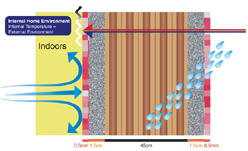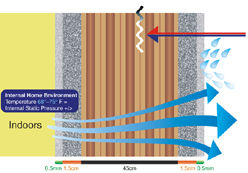Until the end of the 19th Century the materials used for construction were all natural: stone, brick, wood, ceramic, and lime based cement or concrete. Lime paints, lime stuccos, potassium silicate paints, lime cements, were the industrial materials for construction that had endured for over 3,000 years of human construction for habitations. With the advent of the industrial revolution, particularly the petro chemical industry, there was introduced into the market experimental building materials that had not taken any consideration of climate conditions, history, building traditions, and certainly not health, when “new“ products were introduced to substitute proven technologies that had remained constant in performance and respect to the environment for 3,000 years. In effect, the “new” technologies erased the aspect of a house from being “healthy” to an ambient completely artificial, even aggressive, toward the aspect of human habitation.
Masonry walls, floors, roofs, made from natural materials that breathe, are permeable, and ecological have natural temperature and humidity controls that keep a house healthy and comfortable during all seasons of the year, and with available solar technologies can be practically heated and cooled without the need of furnaces or air conditioners run by methane gas, liquid gas, diesel, or electricity.
A House that Breathes is made of a natural masonry material such as extruded brick block, stone, solid brick, and lime based mortar. New extruded aerated bricks made of baked clay now cost the price of a concrete block and can provide up to an R factor of 60+ (using no chemicals or insulation), or a U factor (taken into consideration total wall construction, interior and exterior stucco, natural paints, etc.) of U - 15. This is the basis for a Roman house. Essentially a Roman Domus built in 200 BC maintains an average yearly temperature of 55 F° - 75 F° without any auxiliary heating or cooling.
Lime based cements (NHL 3.5), non Portland based cements, Lime based paints, and Potassium mineral paints, that cover the interior walls of a house, calcify by absorbing the CO2 that is produced by its inhabitants. In addition to the walls being a magnet for toxins that can develop in atmosphere of a house, the porosity of natural cement absorbs the internal humidity, and through natural capillary action of natural aggregates (river sand), and NHL cement, natural mineral paints and plasters, redistributes equally through the walls for the entire structure, the moisture and air, and moves them toward the outside walls. San Marco USA Natural Mineral Paints and Plasters, Natural Cement, provide a rapid and continuous interchange of internal air that moves from the inside to the outside.
This is also facilitated by natural forces such as gravity (internal static pressure), and by physics of molecular expansion: that the internal pressure in a house is greater than the outside pressure, and thus through the natural coolness and heat of constant temperature maintained by thick masonry walls that breathe, the air will move in a slow but continuous movement always from the inside toward the outside. This constant action is what prohibits the ability of rain or water to penetrate through your external masonry walls and bring moisture into your house.
Using San Marco USA Mineral Paints and Plasters, natural cement stuccos, can increase your thermal co-efficiency by 25% when applied to walls that breathe. A House that Breathes means that the continuous flow of air and humidity inhibit the hot or cold air from the exterior environment to penetrate the walls of a house that breathes. In addition to using natural materials such as Mineral Paints, Plasters, and Lime based Cements, these products not only remove internal humidity that can cause bacteria to grow and form mold, but the lime products themselves through high alkalinity prohibit bacteria to form on their surface, and thus the walls of your house cannot form molds and fungus that help contribute toward SBS.
WARNING: A House that Breathes means that the use of a single coat of any non breathable latex based paints or plasters will inhibit the correct function of the capillary function of natural materials and thus annul all the positive functions that these materials can perform to provide thermal co-efficiency, prevent mold, and help to protect your health and your family.
A Non-Breathable Wall

Click each image to see full diagram
The use of historical cements, paints, and plasters, creates a skin that allows your house to act as a igrometro lung (water/air lung) that moves air naturally from the inside to the outside, thus creating better living conditions internally, and guarantees its inhabitants a house of mental and physical well being, or benessere".






